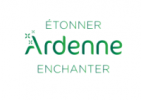RUE PROMENADE DE QUATRE HEURES / N°6
This interesting house was built at the beginning of the 20th century according to the plans of the architect Marcel Hansen. All the characteristics of the Art Nouveau style can be found here. The cladding gives the façade a lot of light. It consists of white bricks interrupted by three bands of grey limestone on the upper floor. The high base of sandstone and limestone rubble is pierced by a large cellar window with a sinuous frame. It is protected by a beautiful wrought iron grille under a mosaic panel forming a red flower decoration. This panel, which is very modern for its time, is at the level of the passers-by and contributes to the polychromy of the façade. The door's joinery also belongs to the Art Nouveau style. So does the window above it, with its pointed arch in light blue bricks and its partially erased sgraffito panel. Sgraffito is a design incised with a fine chisel into a fresh wall plaster applied to a coloured stucco background. The lines of the incised drawing make the figures clearly legible to the viewer. This technique requires rapid execution and great dexterity. On the right, on the first floor, the bow window is supported by a triple wrought iron console whose design and curves suggest finesse and lightness. Under the cornice, panels of sgraffito decorated the semi-circular transoms. All the original woodwork has been preserved, with the larger windows having coloured stained glass. The building you see at the end of the square, on the left, is the Town Hall of Spa. Go back towards the Tourist Office and turn right into the Rue du Marché.
into the rue du Marché. Take the Rue Royale and stay on the right-hand pavement. On your left you will see the Casino and the Anciens Bains. The former Spa thermal baths have been part of Wallonia's exceptional heritage since October 2016. Restoration work is underway and will make way for a luxury hotel, with shops, flats and parking spaces.
You are now in Place Royale. On your right, you can see the Parc de Sept-Heures and the Pavillon des Petits Jeux, which now houses a micro-brewery: LA BOBELINE. Another exceptional heritage of Wallonia, the Galerie Léopold II, which you can see behind the pavilion, is a covered walkway typical of the water cities of the late 19th century. It connects this pavilion to the Marie-Henriette Pavilion (at the back of the park), which is also listed. Now take a closer look at the red brick building at the entrance to Avenue Reine Astrid.
Reception








